Ed Gorman's Blog, page 97
March 18, 2014
THE GRITTY CINEMA OF JOHN FLYNN
The Gritty Cinema Of John Flynn
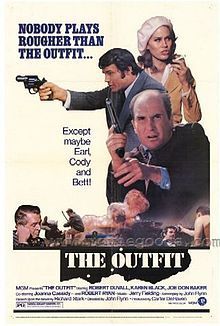 Ed here: I watched "The Outfit" last night and it was as dazzling and powerful as ever. Duvall IS PARKER.
Ed here: I watched "The Outfit" last night and it was as dazzling and powerful as ever. Duvall IS PARKER.Here's a very good Movie Fanfare piece on the sadly forgotten director John Flynn.
For the entire piece go here: https://www.moviefanfare.com/john-fly...
by Irv Slifkin
Somewhere in Movieland, there’s some kind of radar that tracks film directors. Blipping prominently on the screen would be the likes of Ford, Welles, Capra, Hawks, Spielberg, Kurosawa, Kubrick, Tarantino, Scorsese and Lean.There’d also be filmmakers who barely register, no matter how sensitive the tracking device is. One such man behind the camera who turned in terrific work on a regular basis but hardly made a blip was John Flynn.Even the name is forgettable. A recent conversation with a friend—about the 1973 Robert Duvall film The Outfit—led me to ask myself: Who directed that? As I pushed aside the cobwebs of my mind, I recalled it was John Flynn, which prompted me to do some further investigation. Damn, this guy made some terrific genre films, though his most people—movie buffs included—would be hard-pressed to name them.A Chicago native who grew up in Hermosa Beach, California, Flynn served in the Coast Guard and attended UCLA for journalism. He hooked up with director Robert Wise, with whom he worked as an apprentice on Odds Against Tomorrow, and as script consultant on West Side Story. He directed the second unit for several films, including the Elvis Presley boxing vehicle Kid Galahad, the romantic drama Two for the Seesaw, the war epic The Great Escape, and the all-star farce What a Way to Go!, before graduating to helming his first feature.It was, in fact, Wise that Flynn credited with helping him start his career. Wise enlisted Flynn to direct 1968’s The Sergeant, which the veteran director produced. Set in 1952, the film centers on an American sergeant (Rod Steiger) stationed in France who is attracted to a recently-arrived soldier (John Phillip Law), and insinuates himself the subordinate’s life with tragic results. The film is now looked upon as a seminal example of how homosexuality was depicted in movies, but it failed to make an impression on audiences despite its controversial nature and Steiger’s strong performance as the tortured lead character.Flynn didn’t fare much better with the non-reception greeting The Jerusalem File, a 1972 drama with Bruce Davison as an American college student in Israel getting caught up in politics after the Six Day Arab-Israeli War.The Outfit (1973) changed Flynn’s career trajectory, at least in the eyes of the critics, if not the public. In this tightly-wound, often explosive noir, which Flynn expertly adapted from a “Parker” story by Donald Westlake (aka Richard Stark), Robert Duvall played an ex-con who learns his brother has been gunned down while he was in prison. It seems that a crime syndicate believed the sibling robbed a bank under their control. Duvall, hot off of The Godfather, teamed with craggy former partner Joe Don Baker for a direct confrontation with the mobsters, led by the sinister Robert Ryan (in one of his last roles). Westlake himself called The Outfit the best film adaptation of his fiction, which would include Point Blank, Payback, The Split and others just in the Parker series alone. It’s certainly clear why the film is a success, from Flynn’s no-nonsense direction and clipped dialogue, to ace cinematography by Bruce Surtees of dusty, depressed California locales (prominently Bakersfield), to a terrific cast that also includes Karen Black and several veterans of classic film noirs (Timothy Carey, Elisha Cook, Jr., Marie Windsor, Jane Greer).Duvall and Baker, the heroes of the piece, are not very likable; another troubling element of the film is how the women are treated. Black, as Duvall’s girlfriend, gets slapped around and often comes off as a whining pain-in-the-neck; a debuting Joanna Cassidy, playing Ryan’s trophy wife, basically gets berated and ordered around by her older husband throughout the film.Revenge was also the name of the game in Rolling Thunder, his alarmingly violent drama based on Paul Schrader’s screenplay (reworked by Fort Apache: The Bronx’s Heywood Gould). The 1977 effort centers on an Air Force flyer (William Devane) who returns to his hometown after spending years in a POW camp, to find his wife remarried and his son unaware of who he is. He’s targeted by a group of vicious thugs out for his compensation pay, who torture him—leaving him with a life-altering disability—and kill his wife and son. Snapping, Devane goes on a rampage, recruiting ex-POW pal Tommy Lee Jones to bring vigilante justice to the perps.No easy viewing, Rolling Thunder, recently issued in an extras-packed Blu-ray release (and already available on DVD), had a rough ride to neighborhood screens. Its release history was marked by a studio (Fox) abandoning it, a marketing screening that drew walk-outs and nearly a unanimous negative reaction from the audience, mixed response from critics (“In sum, it neither rolls nor thunders,” commented Variety) and, finally, a lackluster theatrical run by way of low-budget specialist American International Pictures.
Published on March 18, 2014 13:00
March 17, 2014
SLAMMER by Allan Guthrie
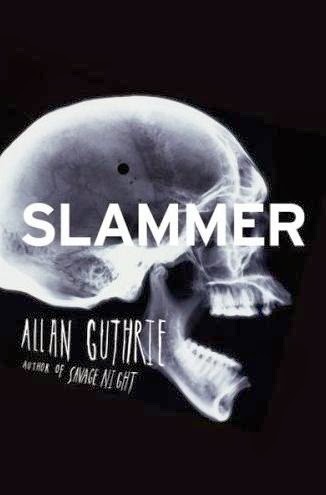
To make things worse Nick is approached by one of the inmates and asked to mule drugs inside. The inmate gives him two choices: 1) make an easy buck; or 2) his little family gets hurt in a big way. Nick is in big trouble as he desperately tries to protect his family at home and his own life at work.
Slammer is the sort of novel that creeps up on you in about three pages. It starts hard and strong and never lets up. Glass is a regular guy caught in a nasty and impossible situation. He doesn’t belong in the prison. He is a nice guy, both weak and sincere. He, much like his name, is prone to fracture. And Guthrie makes sure Glass does just that.
The novel opens with Glass in the office of the prison psychiatrist. It is a mandatory visit and Nick is less than pleased to be there. The psychiatrist is an instrument Mr Guthrie uses to foreshadow and then define the undoing of Nick. He is a skewed sentiment of sanity in a dark and insane world. A world that envelopes Nick and threatens to destroy him. And Nick is the perfect object—he is prone to fantasy, and as the novel progresses, he begins to mistake his fantasy for reality. It is a trip into hell. A trip the reader knows is coming with each progressive sentence, paragraph and page, but is helpless to stop.
Slammer is a wonderfully executed novel. It is reminiscent of Guthrie’s first novel Two-Way Split, but its execution is better (amazingly). It is short, 263 pages, but it does not lack meaning or story. The prose is hardboiled, lean and smart. The dialogue is crisp, and the atmosphere is weighty and oppressive. It is a fine example of the new noir: a hopeless, distraught and shameless (in a good way) vision of the human condition.
This is an encore post. It originally went live on November 23,2009.

Published on March 17, 2014 13:27
March 16, 2014
THE CLASSIC WESTERN IN TWILIGHT II: SHOWDOWN
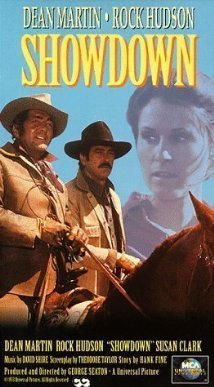
THE CLASSIC WESTERN IN TWILIGHT II: SHOWDOWN
Like Henry Hathaway’s SHOOT OUT, which I discussed on Ed’s blog earlier, SHOWDOWN (1973) came out as the classic high tide era of the American Western (1940s to the mid-1970s) was nearing its end. George Seaton directed (he’d been writing movies since the 1930s, and directing since the ‘40s), Theodore Taylor delivered a thoughtful script, and Rock Hudson and Dean Martin starred. Giving two old-timers shared billing above the title was common in the twilight decline of the classic Western. Today’s filmmakers use the same tactic to lure aging action-movie fans to see Stallone and Schwarzenegger in the same picture.
Billy (Dino) and Chuck (Rock) are lifelong buddies, ranching partners, and rivals for the town’s pretty boardinghouse cook, Kate (Susan Clark). Kate weds Chuck, and Billy decides to move on. This is all backstory, told in dialogue and flashbacks --maybe a nod to the flashbacks in the popular post-classic Westerns of Sergio Leone and Sam Peckinpah.
Billy joins a trio of train robbers and becomes one of the inside men on a heist, posing as a lawman escorting a “prisoner” to jail. BANDOLERO!, a twilight Western from 1968, featured a similar trick when James Stewart poses as a hangman to bust his brother, another role played by Dean Martin, out of jail.
When his partners shortchange Billy after a heist and the guns come out, he kills one of them and escapes with the money. Chuck catches him and says he can promise clemency if Billy returns the loot and reveals the names of his partners. But the town’s spiteful prosecutor rescinds the deal while Chuck is out of town, and Billy breaks jail with the money. Chuck follows, as do the former partners who want the loot.
Like SHOOT OUT, the movie takes time to round out its characters, maybe more time than today’s younger filmgoers are likely to accept. The sheriff’s hardscrabble ranch looks authentic, not a prettied-up Hollywood set, and Dino, Rock, and the future Mrs. Alex Karras all turn in good performances. The real, non-CGI outdoor locations are eye-catching, and if you look fast, you’ll spot Ed Begley Jr. in a small part as a stable hand.
Unfortunately, either the producers were unwilling to budget extensive time for Hudson and Martin for a full location shoot, or the two stars had tight schedules (both were starring in TV shows around this time). When Chuck tracks Billy in the mountains in the final scenes of the movie, they’re photographed mostly from a distance or from behind. After awhile, it becomes evident that the two men on the screen are Dino’s and Rock’s stand-ins, and not the two stars themselves, whose voices are simply dubbed on the soundtrack. This is a lapse in an old-fashioned production that otherwise does most things right.
Published on March 16, 2014 16:45
March 15, 2014
The Innumerable Short Stories of Theodore Sturgeon by Andrew Liptak from Kirkus
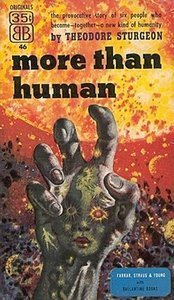
The Innumerable Short Stories of Theodore Sturgeonby Andrew Liptak on March 13, 2014https://www.kirkusreviews.com/feature...
Some authors make a name for themselves with a handful of acclaimed and popular stories (Ted Chiang), while others go for sheer volume (Isaac Asimov), and then there’s a couple who are popular for their sheer volume and consistent quality of stories. Theodore Sturgeon was one such author writing during the middle of the science-fiction boom of the 20th century, putting together some of the genre’s best known and beloved works over the course of his long career as an author.Born Edward Hamilton Waldo on February 26th, 1918, the future science-fiction author came from a troubled household. His father, Edward Molineaux Waldo, was absent for most of his early childhood, and eventually divorced his mother in 1927. With his mother’s remarriage two years later, Edward received a new last name, Sturgeon, and an indifferent stepfather who appears to have been exceptionally cold toward his adopted children. The young Sturgeon faced further difficulties in his teenage years: an exceptional gymnast, he contracted rheumatic fever, which affected his heart and ended his potential career. His stepfather introduced him to some science fiction, even as he forbade pulp magazines: They read stories such as The Time Machine by H.G. Wells and Twenty Thousand Leagues under the Sea by Jules Verne. Over the years, Sturgeon picked up a range of the forbidden pulp magazines and read authors such as Lord Dunsany, William Hope Hodgeson, William Morris and others.After high school, Sturgeon left for the Penn State Nautical School, where he enrolled for a single term before leaving for the sea, working on a ship’s engine room. It was over the next three years that he began his incredible fiction output. He sold his first story to McClure's Newspaper Syndicate in 1937, and followed up with over 40 others, eventually making his way back to New York City.
Published on March 15, 2014 16:03
March 14, 2014
PAPERBACK PARADE GOES FULL COLOR!
[image error]
[image error]
by Gary Lovisi, Publisher
It's been a dream of mine for over 25 years -- since I first began
publishing Paperback Parade -- my collectable paperback magazine -- way back
in 1986 to have the entire issue in full color. It was a dream because the
cost for color printing was just insane so it was a dream I never thought
would come true. Now after 25 years the technology has caught up with my
desire and color has become somewhat more affordable and we have a beautiful
new issue of paperback Parade #85, just out -- in FULL GLORIOUS COLOR!
Thanks to the hard work of ace designer Richard Greene, the magazine has
a great new look, 2-columns, full color 100+ pages on quality paper -- all
to better show the wonderful gorgeous cover art on collectable and vintage
paperbacks. Of course this issue has the usual excellent articles readers
have expected form PP -- and now amazing color covers that make each turn of
the page a fun-fest pulp extravaganza!
In this issue I am proud to present the usual great stuff, 20 pages of
"Paperback Talk" with news, new books, letters, and more, then "The Literary
Life of Dr. J. Calvitt Clarke" by J. Calvitt Clarke III, the life of a
fascinating man who wrote many socially aware but often risque books and
also crime novels in 1920s-30s, some of which became sexy digest paperbacks
in the 1950s. There is an appreciation of SF writer Neal Barrett Jr. by Jon
D. Swartz, an interesting cover swipe by Alex Henzel; "The Life and Death of
Rik Davis" by Dale Brunfield, a beat poet who wrote sleaze as Jack Vast; Guy
Endore the author of The Werewolf of Paris; a look at crime author Bruno
Fischer by Ed Lynskey; and "Hard-boiled Paradise" by Gary Lovisi, my own
examination of hard crime classic vintage paperbacks -- each page
illustrated with full color covers from dozens and dozens of rare and very
cool books! It's a feast for the eyes!
Paperback Parade #85 is available for $15 + postage ($3 in USA), or you
can take out a 3-issue subscription for $40 in the USA; $55 in Canada; all
other foreign $65.
You can pay with check, money order, or use VISA, Mastercard, or Paypal.
To find out more info see my website: www.gryphonbooks.com.
Email: gryphonbooks@att.net
Next issue there are more changes in store, such as new perfect binding
and more great color covers! If you like reading or collecting books this is
a magazine you should be getting. I hope you will give it a try.
Gary Lovisi
Gryphon Books
PO Box 280209
Brooklyn, NY 11228
USA
Published on March 14, 2014 15:09
March 13, 2014
THE CLASSIC WESTERN IN TWILIGHT: SHOOT OUT by Fred Blosser

THE CLASSIC WESTERN IN TWILIGHT: SHOOT OUT
by Fred Blosser
Shoot Out, the final Western by the great Henry Hathaway, mostly earned poor critical notices when it played movie theaters in 1971. Roger Greenspun’s New York Times review called it “the kind of movie that everyone walks through.” Others dismissed it as an unsuccessful attempt by Hathaway (director), Hal Wallis (producer) and Marguerite Roberts (screenwriter) to ride the coattails of their earlier collaboration on True Grit.
Critics might have been kinder if they had known that the classic American Western was headed for slow extinction by 1971, as Hathaway and other elder statesmen of the genre drifted into retirement or death. From a vantage point more than 40 years on, Shoot Outisn’t a masterpiece to rank with True Grit or Hathaway’s 1958 feature From Hell to Texas (a favorite of William K. Everson’s), but it’s better than the drubbing by Greenspun, Charles Champlin of the Los Angeles Times, and other contemporary critics would imply.
Released from prison, bank robber Clay Lomax (Gregory Peck) sets out to find his partner Foley (James Gregory), who shot him in the back on their last job, left him for dead, and got away with the haul. Lomax wires his former girlfriend Teresa, a prostitute, to bring him the savings he had entrusted to her before the robbery. Teresa dies en route, and in addition to the the cash, she leaves Lomax her eight-year-old daughter Decky (Dawn Lyn), whom Lomax assumes is also his daughter.
As you’d expect from Hathaway, the visual style of the movie is clean and straightforward, filmed against beautiful New Mexico and California wilderness scenery. Hathaway employs Peck’s reserved demeanor to good effect, helping the movie mostly steer clear of bathos, as Lomax slowly warms to the idea of being a father and begins to see a purpose in life other than revenge.
Hathaway and Roberts also skirt sentimentality by portraying Lomax’s West mostly in hard-edged, unromantic terms. Three young gunmen dispatched by Foley to trail Lomax seem borderline-retarded, easily cowed by their ringleader, Bobby J. (Robert Lyons), a loudmouthed troublemaker. The girls at the Boots & Saddle saloon are hookers who live and work in the joint’s back rooms. One of them, Alma (Susan Tyrell), has a bruised face from rough handling by a previous customer, and when Bobby J. takes her to bed it becomes a noisy threesome with Bobby J.‘s flunky Skeeter.
In Little House on the Prairie, Lomax would have found a welcoming home for the little girl among the respectable townsfolk. Here, the local preacher suggests she be turned over to the marshal. So do the storekeeper and his wife, who says, “I never wanted children anyway.” The only person Lomax meets with parental feelings is a lonely widow rancher with a young son (Pat Quinn), who takes him and Decky in out of a storm.
Leonard Maltin’s review faults the movie for more talk than action, but there’s a fair amount of gunplay, and the dialogue underscores the realism of Hathaway’s West, where circumstances can force a good person into a dilemma that presents no easy out. When Bobby J. invades the widow’s home, sadistically insists on demonstrating his skill with a gun by shooting a cup off one of the kids’ heads, and asks the widow to choose which kid it will be, her boy or Decky, she chooses Decky. “I’m so sorry, but it was my son,” the widow later tearfully apologizes. “Likely I’d have done the same in your place by choosing the boy,” Lomax concedes.
There is a happy ending, and end-of-career appearances by the great Western veterans Paul Fix, Jeff Corey, Arthur Hunnicutt, and Willis Bouchey in bit parts. The late John Davis Chandler plays Skeeter. No one ever played unstable but pathetic losers of society as well as John Davis Chandler did.
Published on March 13, 2014 18:18
March 12, 2014
THE BITTER NOIRS OF MARK STEVENS: CRY VENGEANCE (’54) AND TIMETABLE (’56)
THE BITTER NOIRS OF MARK STEVENS: CRY VENGEANCE (’54) AND TIMETABLE (’56)
 Posted by R. Emmet Sweeney on August 6, 2013 From Movie Morlocks
Posted by R. Emmet Sweeney on August 6, 2013 From Movie Morlocks

Second-tier actor Mark Stevens directed two first-rate film noirs in the 1950s, Cry Vengeance (1954) andTimetable (1956). Made when his acting career was in decline, these are self-lacerating works in which Stevens casts himself as a physically and morally disfigured criminal, as if doing penance for his Hollywood failures. In both films America is a prison his characters are desperate to escape, a repository of the fearful past. The destinations of his flight take on symbolic weight, from the vertiginous heights of Ketchikan, Alaska in Cry Vengeance (shot on location), to the neon claustrophobia of the studio Tijuana in Timetable. Stevens, a former handsome romantic lead, plays his obsessives with bitter quietude, his delivery a strangled monotone, as if he is devouring his own charisma. These are strikingly melancholy works made in near anonymity for Allied Artists (formerly known as Poverty Row studio Monogram), and thanks to Olive Films Cry Vengeance is now available in an appropriately funereal B&W Blu-Ray. Timetable is in public domain hell, and is viewable in various samizdat versions on YouTube.

Born Richard William Stevens in Cleveland, his name was changed to Stephen Richards as a contract player for Warner Brothers. Most able-bodied men were enlisted to fight in WWII, but Stevens had long-time back problems that exempted him, stemming from a diving accident that incapacitated him for months as a teen. It bothered him all his life, lending his motions a stuttered, tortured quality appropriate to noir heroes. He gained his modicum of fame after he jumped to 20th Century Fox. It was there that Daryl Zanuck dubbed him “Mark Stevens”, and his short-lived career as a leading man began, from Henry Hathaway’s noir The Dark Corner (1946) to the Oscar-nominated melodrama The Snake Pit (1948). They also tried him in light musicals (Oh You Beautiful Doll (’49)), but they released him from his contract in 1950. Hathaway blamedThe Dark Corner’s box office failure on Stevens, saying he, “never quite cut it. Too arrogant, cocksure.” Once one of the top ten actors “Most Likely To Achieve Stardom” in a 1946 Motion Picture Herald poll, Stevens had to take whatever work was available. In the early ’50s he moved on to a few mid-budgeted action-adventures at Columbia and Universal-International before he finally went bust at the big studios, and had to move into the independents, while expanding his work in TV. He nabbed a starring role in the short-lived ABC series News Gal (1951), and went on to a prolific career on the small screen, from the newspaper drama Big Town (1954 – 1956, which he also produced) all the way to guest spots on Magnum P.I. andMurder She Wrote.
for the rest go here:
http://moviemorlocks.com/2013/08/06/t...
Published on March 12, 2014 15:02
March 11, 2014
News from Robert J. Randisi
News from Robert J. Randisi

It’s all about BROOKLYNRobert J. Randisi
In 2011 my novel, THE END OF BROOKLYN, was published. It was meant as the third and final entry in what turned out to be a “Nick Delvecchio” trilogy. Why it came 20 years after the second nook is a mystery, even to me. but because it did it had to be written that way. In parts of the book, Nick had to be 20 years older. It was a joy to write, mainly because I was able to go back to Nick and Brooklyn 20 years after I, myself, had left them. This was what my Booklist review looked like* Starred Review Booklist. "The final entry in Randisi's Brooklyn trilogy is dark, brooding, and thoroughly compelling [with] . . . clever plotting and an engaging narrative voice. Randisi has written hundreds of crime stories and earned numerous awards. This is among his finest efforts." (Wes Lukowsky, Booklist, May 2011).
It was very gratifying for two reasons. One, I wasn’t sure how Nick and Brooklyn would sound 20 years later and two, We Lukoswksy had reviewed a lot of my work over the years, so his opinion in very informed.
END was published by Perfect Crime in 2011, and now, in 2014, they are bringing back the first two books, NO EXIT FROM BROOKLYN, and THE DEAD OF BROOKLYN. So for the first time all three “Delvecchio” novels are available at the same time from the same place. “Nick Delvecchio” is one my my best, my favorite, and my most fully realized characters. (Available from Amazon, B&N, the PerfectCrime website, and many mystery bookstores).
Published on March 11, 2014 14:59
March 10, 2014
Margaret Maron Past Imperfect
The name Margaret Maron isn't usually found on lists of the finest hard boiled even noirish crime fiction writer but as her latest reissue from Oconee Spirit Press demonstrates she deserves to be.
In Past Imperfect Maron takes us into the heart of 90s New York City (think sleaze everywhere) and embroils Sigrid Harald, one of the police procedural's most fascinating characters, in a case that appears to be simply about the murder of an off duty police officer.
But this is a case with echoes involving the long ago death of her own father. Making his passing vivid and timely is the internal investigation report written by a black officer whose comments provide suspenseful counterpoint to Harald's present day investigation.
Marion is a fine stylist, a subtle yet powerful storyteller and an experienced guide through the vale of tears we all trod through.
This is my favorite of the Harald novels I've read so far.
Published on March 10, 2014 20:01
March 9, 2014
Haffner Press Newsletter A Bonanza
[image error]
 [image error]** ALERT: New Email Address **
[image error]** ALERT: New Email Address **We're changing ISPs! Effective immediately, our e-address will be haffnerpress@comcast.net
info@haffnerpress.com remains the sameIn This Issue: February 27, 2014
• REIGN OF THE ROBOTS, Coll. Hamilton #4
• CAPTAIN FUTURE, Vol, #3
• JOHN THUNSTONE Limited Edition
• 2014 Jack Williamson Lectureship
• FREDRIC BROWN Update
• Find us on FACEBOOK
 THE REIGN OF THE ROBOTS, THE COLLECTED EDMOND HAMILTON, VOLUME FOUR
Introduction by Mike AshleySome feedback and links to reviews on this fast-selling title:"Thanks to Haffner Press and Stephen Haffner for putting out such handsome, lovingly produced editions of often formulaic and unabashedly pulpy but visionary, and sometimes seminal, early stories." —Alvaro Z. Irvine, CA."...shows Hamilton with about 5 years of writing for pay under his belt, and contains both his old hyperbolic space opera and a few quieter, more introspective pieces. Its mostly sci-fi, but there is a genuine weird tale, and a little vampire story. Best of all, its enjoyable reading from start to finish...Adding to this is the collection of letters to the editor of the various magazines Hamilton was published in: it's like a really slow moving internet forum, only far more literate and with fewer smileys and links to cat pictures. Mort Weisinger, Forry Ackerman, Lin Carter: all these names appear here putting a point of view. Its great stuff, even with the odd glacial speed flame war or two." —John Middleton., Brisbane, Australia.
THE REIGN OF THE ROBOTS, THE COLLECTED EDMOND HAMILTON, VOLUME FOUR
Introduction by Mike AshleySome feedback and links to reviews on this fast-selling title:"Thanks to Haffner Press and Stephen Haffner for putting out such handsome, lovingly produced editions of often formulaic and unabashedly pulpy but visionary, and sometimes seminal, early stories." —Alvaro Z. Irvine, CA."...shows Hamilton with about 5 years of writing for pay under his belt, and contains both his old hyperbolic space opera and a few quieter, more introspective pieces. Its mostly sci-fi, but there is a genuine weird tale, and a little vampire story. Best of all, its enjoyable reading from start to finish...Adding to this is the collection of letters to the editor of the various magazines Hamilton was published in: it's like a really slow moving internet forum, only far more literate and with fewer smileys and links to cat pictures. Mort Weisinger, Forry Ackerman, Lin Carter: all these names appear here putting a point of view. Its great stuff, even with the odd glacial speed flame war or two." —John Middleton., Brisbane, Australia.
• Black Gate Magazine • N ew York Journal of Books
This book is also offered as part of an "early bird combo" with THE COLLECTED CAPTAIN FUTURE VOLUME THREE and THE SIX SLEEPERS, THE COLLECTED EDMOND HAMILTON, VOLUME FIVE along with an exclusive chapbook, TIGER GIRL. Details at www.haffnerpress.com.
 THE COLLECTED CAPTAIN FUTURE, VOLUME THREE
THE COLLECTED CAPTAIN FUTURE, VOLUME THREE
Introduction by Chuck Juzek Some feedback and links to reviews on this cosmic tome:"This is science fiction in the grand tradition,namely space opera .the characters are good and quirky.the stories are larger than life and that dialogue is just fun to read." —Bobby D., Henderson, TX.
"I’m a huge Edmond Hamilton fan and some of his best writing can be found in these Haffner tomes. Yes, this is pulp writing, but pulp writing at high level. The original covers are reproduced and there’s a nice selection of interior illustrations included, too. If you’re in the mood for some Sense of Wonder early Science Fiction, you’ll find it here!" —George K., North Tonawanda, NY.
"Terrific stuff. My first intro to Captain Future was through re-issues of the pulp tales as paperbacks back in the late 60s or early 70s. Total fun to read!" —Bob K., Waukesha, WI.
• Scoop/Diamond Galleries •Ed Gorman's Blog
This book is also offered as part of an "early bird combo" with THE REIGN OF THE ROBOTS, THE COLLECTED EDMOND HAMILTON, VOLUME FOUR and THE SIX SLEEPERS, THE COLLECTED EDMOND HAMILTON, VOLUME FIVE along with an exclusive chapbook, TIGER GIRL. Details at www.haffnerpress.com.
 Dustjacket for Limited Edition
Dustjacket for Limited Edition•
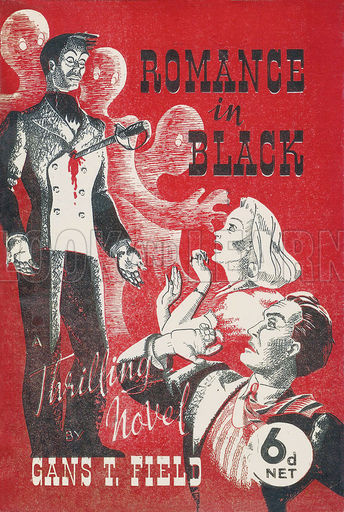 Housed in a matching Black Arrestox-cloth slipcase, the 100-copy Limited Edition of
THE COMPLETE JOHN THUNSTONE
by Manly Wade Wellman features a Raymond Swanland-illustrated limitation sheet signed by Ramsey Campbell (intro), Raymond Swanland (cover artist), and Stephen Haffner (editor).
Housed in a matching Black Arrestox-cloth slipcase, the 100-copy Limited Edition of
THE COMPLETE JOHN THUNSTONE
by Manly Wade Wellman features a Raymond Swanland-illustrated limitation sheet signed by Ramsey Campbell (intro), Raymond Swanland (cover artist), and Stephen Haffner (editor). The book is printed with variant endpapers from the trade edition,wrapped in an exclusive dustjacket showcasing the original art, and will also ship with a rolled copy of the trade edition dustjacket.
An exclusive chapbook, ROMANCE IN BLACK, collects all five of Wellman's "Judge Pursuivant" stories with interior illustrations byGeorge Evans (originally done for Carcosa's Lonely Vigils) with never-before-published art for "Chastel," the last Pursuivant story from 1979. (The cover is from an extremely rare British WWII-era pamphlet from Utopia Publications.)
Finally, should you decide to add this mighty package to your library, you will receive an authentic autograph of Manly Wade Wellman. THE CHOICE IS YOURS: This autograph will be *cut* from one of Wellman's personal checks and mounted to the limitation sheet, OR you may choose to receive the whole *un-cut* check laid loosely into the book. Only a few unreserved copies remain.
[image error] The 38th Annual Jack Williamson Lectureship on April 3-4, 2014
Guest of Honor: Darynda Jones (The Charley Davidson Series. The Darklight Trilogy)
Special Guest: Arthur M. (Art) Dula, space lawyer, patent attorney, and the literary executor for science fiction author Robert A. Heinlein. He is also chairman and founder of the private spaceflight computer, Excalibur Almaz.
Theme: The Wide World of Speculative Fiction!
Events:
Thursday:
• 6:00 pm Reading by Darynda Jones
Friday:
• 9:30-11:30 am Readings by visiting authors
• 12-Noon Luncheon ($10, payable at door, reservations are required)
• 3-6 pm SF/Fantasy Panels (topics are tentative)
-The Art of SF/Fantasy Illustration -Science in Heinlein and Early SF (with a focus of Frederik Pohl) -Short-Attention Span Panel -Advice for Beginning Writers -Young Adult Speculative Fiction -New Directions in SF/Fantasy Film and Fiction
Reservations for the lectureship luncheon can be made by calling 575.562.2315 or emailing Patrice.Caldwell@enmu.edu


To borrow a phrase:
"It's almost soup!"
We'll have a much more informative update once MURDER DRAWS A CROWD goes to the printer, but right now we wanted to share that:• The retail price for MURDER DRAWS A CROWD will likely be $45 on publication, so placing a $40 single-copy preorder (or take advantage of the$105 Fredric Brown/Howard Browne combo at www.haffnerpress.com) is strongly recommended.
• The manuscript for MURDER DRAWS A CROWD has been proofread. That's 744 pages, mon frere.
• Jack Seabrook has delivered a knock-out introduction.
• Artwork from the original pulps for all 38 stories are refurbished and set in the layout.
• Recently discovered artwork for Brown's "V.O.N. Munchdriller's" stories from THE DRILLER magazine have been acquired.
• Sixty (yes, 60!) fresh images for the "Williams Z. Williams" stories from EXCAVATING ENGINEER will soon be in hand.
• A high-resolution image of the dynamic original art by Norman Saunders from VARIETY DETECTIVE 1938 (and TEN DETECTIVE ACES, 1947 apparently) has been procured.

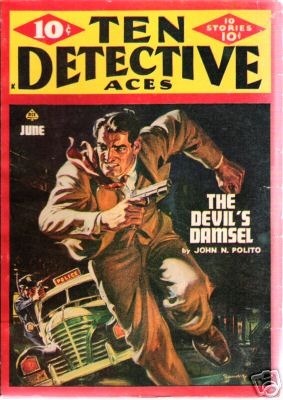 (Images from Phil Stephensen-Payne, Galactic Central Publications.)
(Images from Phil Stephensen-Payne, Galactic Central Publications.) That's it for now. To ensure that you continue to receive this newsletter, be sure to addhaffnerpress@comcastl.net and info@haffnerpress.com to your email reader's "safe list." And, remember, shipping is FREE in the continental United States. Alaska, Hawaii and International orders should email us at
info@haffnerpress.com
for shipping rate quotes.
That's it for now. To ensure that you continue to receive this newsletter, be sure to addhaffnerpress@comcastl.net and info@haffnerpress.com to your email reader's "safe list." And, remember, shipping is FREE in the continental United States. Alaska, Hawaii and International orders should email us at
info@haffnerpress.com
for shipping rate quotes. You're receiving this message because you requested to be notified of events at Haffner Press, or have done business directly with Haffner Press in the past. If you do not wish to receive these messages in the future, unsubscribe and request to have your name removed.
.
Copyright © 2014 HAFFNER PRESS
5005 Crooks Road • Suite 35 • Royal Oak, MI 48073-1239
(248) 288-4756 • www.haffnerpress.com
• Keep Watching the Skies! •
Accessible VersionStandard VersionTerms of ServicePrivacy PolicyAbout Our AdsContext SensitiveShortcuts
Published on March 09, 2014 19:56
Ed Gorman's Blog
- Ed Gorman's profile
- 118 followers
Ed Gorman isn't a Goodreads Author
(yet),
but they
do have a blog,
so here are some recent posts imported from
their feed.



